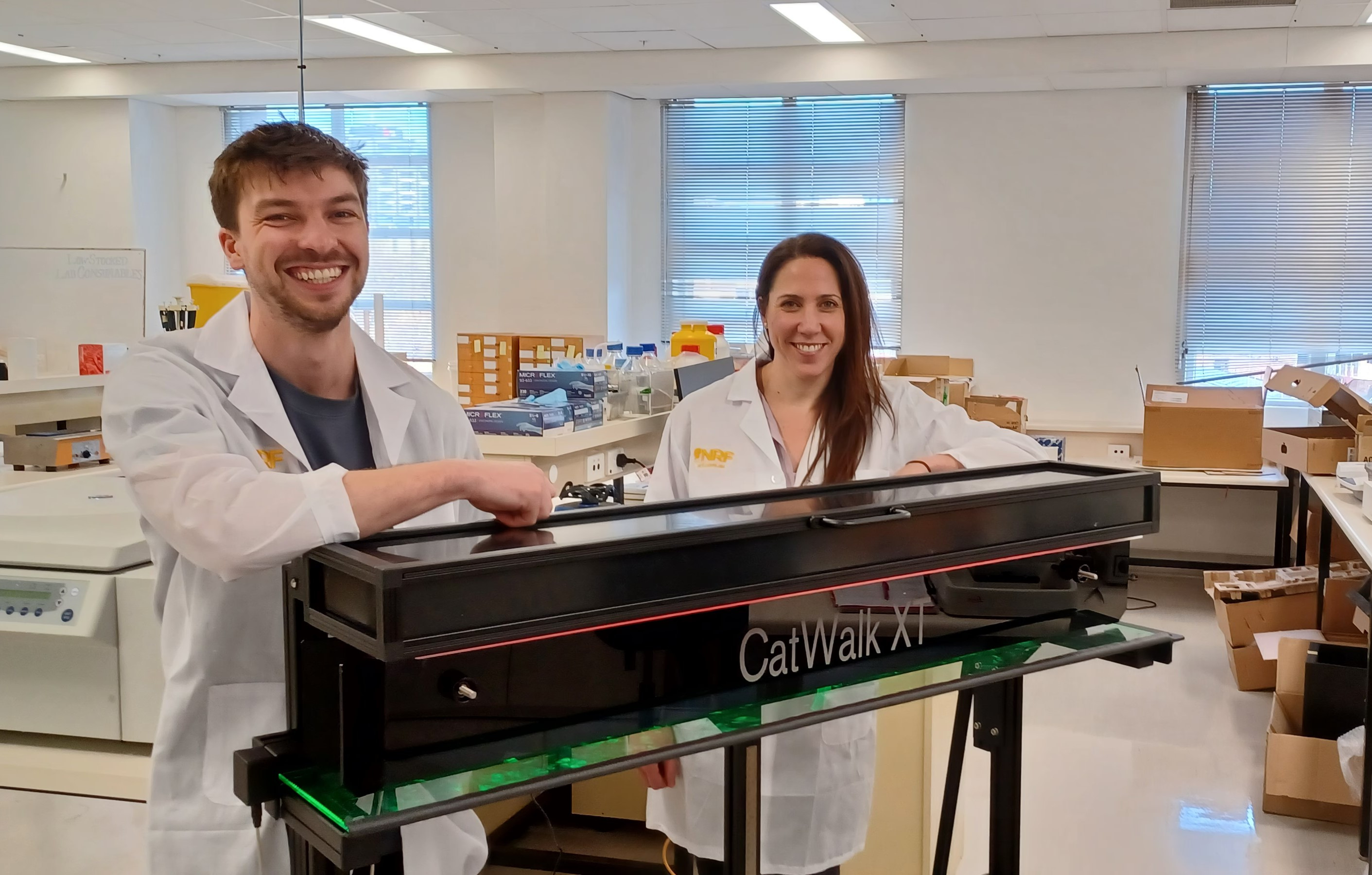Spinal Cord Injury (SCI) also leaves people disabled and needing help with everyday activities. Since there are no effective treatments, funding is urgently needed to find novel therapies to reduce this devastating impact.
With your support, we can fund these life-changing research projects.
Spinal Cord Injury (SCI) leaves patients disabled and dependent for basic daily activities. There are currently no effective treatments available for SCI and novel therapies are urgently required to reduce such devastating disability.

2024 Research Funded:
Funding: $59,020

Neurological diseases or injuries can drastically impair motor function; however, these deficits can be difficult to identify and characterise in preclinical models. The Catwalk is a state-of-the-art system that will allow us to automatically quantify deficits in key motor outcomes, including walking speed, stride pattern, pressure, and coordination. This will enhance our understanding of various pathologies such as Spinal Cord Injury, Traumatic Brain Injury and Stroke, and enable us to examine potential interventions that may one day improve outcomes for people living with these conditions.
Dr Anna Leonard B.HlthSc (Hons), PhD Senior Lecturer in Anatomy & Pathology
University of Adelaide - Adelaide Medical School
Funding: $50,000
Over 15,000 Australians currently live with permanent disability following spinal cord injury (SCI). Many perceive SCI to predominantly affect an individual’s physical ability, however chronic pain develops in 75% of SCI survivors, significantly reducing quality of life. Although normal sensation is lost, the brain creates the perception of pain due to disrupted neuronal signaling. The underlying mechanisms are not well understood, and no efficacious treatments exist. Here we will investigate how a head injury, which occurs in 60% of SCI cases, facilitates development of chronic pain and evaluate the potential mechanisms at play to identify future therapeutic targets.

Dr Anna Leonard B.HlthSc (Hons), PhD Senior Lecturer in Anatomy & Pathology
University of Adelaide - Adelaide Medical School
Funding: $31,688
Project: To improve outcomes and quality of life for individuals with SCI, devices that are minimally invasive, comfortable and effectively alter pain are desperately needed. The current study will investigate a new wireless device called a 'graft antenna', which can be implanted on uninjured peripheral nerves, such as the sciatic nerve and stimulated via electromagnetic induction. We propose that weekly peripheral stimulation via this novel method will reduce neuroinflammation whilst promoting tissue repair and regeneration within the spinal cord itself.
Dr Anna Leonard B.HlthSc (Hons), PhD Senior Lecturer in Anatomy & Pathology
University of Adelaide - Adelaide Medical School
Funding: $17,328
Project: Spinal cord injury (SCI) is traumatic event that often results in profound neurological deficits, significantly impacting the individual’s physical, psychological, and social wellbeing. Up to 810 SCIs occur in Australia annually, causing a significant financial burden on the individual, family and healthcare system.
The lifetime cost per individual is estimated to be $5-9.5m, whilst the annual cost within Australia alone is >$2bn. Accordingly, SCI research is urgently needed and our research team at is expanding to meet this demand. New behavioural equipment will increase the capacity of our research, expanding into the field of chronic outcomes such as neuropathic pain.
Dr Anna Leonard B.HlthSc (Hons), PhD Senior Lecturer in Anatomy & Pathology
University of Adelaide - Adelaide Medical School
Computed tomography (CT) and magnetic resonance imaging (MRI) images are routinely used in neurosurgery for clinical decision making, pre-operative planning and post-operative follow-up.
They provide complementary information but are acquired on different imaging devices and at a separate time. This interrupts the clinical workflow, adds to health-care costs, and poses challenges in registering the images for analysis. Using innovative technologies, our aim is to synthesise spinal CT images from MRI images - providing the necessary MRI information without performing any real CT scans.
This will improve clinical workflow, reduce costs to patients and the health system, as well as help minimise patient exposure to ionising radiation due to a CT scan. The impact also extends beyond spine imaging, notably to paediatric neuroimaging, where childhood exposure to ionising radiation has demonstrable causal effects on the development of cancer in later life.
Dr Gobert Lee
Lecturer in Statistical Science
College of Science and Engineering
Flinders University
Spinal cord injury often servers the communication between the peripheral body and the brain. While the spinal cord itself has been damaged the peripheral nerves remain intact. Electrical stimulation of these nerves has been shown to promote the growth of healthy nervous tissue into and across the injury site of the spinal cord. Whilst electrical stimulation devices have shown some success in motor recovery for individuals with SCI, they remain invasive, bulky and only modestly effective for pain. To improve outcomes and quality of life for individuals with SCI, devices that are minimally invasive, comfortable and effectively alter pain are desperately needed.
The current study will investigate a new wireless device called a “graft-antenna”, which can be implanted on uninjured peripheral nerves, such as the sciatic nerve, and stimulated via electromagnetic induction. We propose that weekly peripheral stimulation via this novel method will reduce neuroinflammation whilst promoting tissue repair and regeneration within the spinal cord itself.
Dr Anna Leonard
Lecturer in Anatomy & Pathology, Adelaide Medical School, The University of Adelaide
Click here to donate to the Traumatic Brain Injury/ Spinal Cord Injury Research Appeal